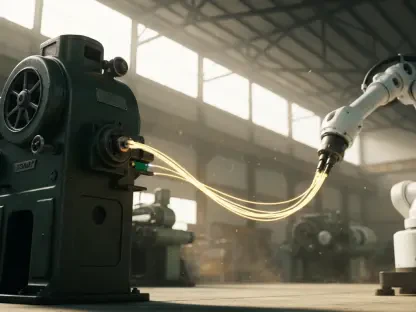Imagine a robot that can glide effortlessly across a smooth factory floor, then, in the blink of an eye, transform its movement to climb a flight of stairs or traverse rugged, uneven ground. This is no longer a vision of science fiction but a reality brought to life by an innovative wheel-legged robotic system known as FLORES. Developed by a team of dedicated researchers, this hybrid robot combines the speed of wheels with the adaptability of legs, addressing a critical challenge in robotics: navigating diverse terrains with efficiency and precision. Such advancements are vital in a world increasingly reliant on robotic solutions for tasks ranging from industrial operations to disaster response.
The significance of this technology lies in its potential to revolutionize how robots interact with complex environments, making them more versatile and practical for real-world applications. This FAQ article aims to answer key questions about this groundbreaking robotic system, exploring its design, capabilities, and implications. Readers can expect to gain a comprehensive understanding of how this robot operates, why it stands out among other designs, and what it means for the future of robotics.
This content will delve into specific aspects such as energy efficiency, unique design features, and potential applications, providing clear insights supported by experimental evidence. By the end, a clearer picture of this robot’s role in advancing robotic locomotion will emerge, offering valuable knowledge for anyone interested in cutting-edge technology.
Key Questions
What Is the Wheel-Legged Robotic System FLORES?
FLORES represents a pioneering hybrid robot designed to combine the advantages of wheeled and legged locomotion. Unlike traditional robots that are limited to one mode of movement, this system can switch seamlessly between rolling on wheels for speed on flat surfaces and using legs to tackle obstacles like stairs or rough terrain. This dual capability addresses a longstanding issue in robotics: the inability of single-mode systems to handle varied environments effectively.
The importance of this innovation cannot be overstated, as many real-world settings—such as urban areas or industrial complexes—feature a mix of smooth and challenging terrains. By integrating both locomotion methods, FLORES offers a solution that enhances adaptability, making it a significant step forward in robotic design. Its development reflects a growing recognition in the field that hybrid systems are essential for practical deployment.
Experimental results have shown that this robot maintains stability in both modes, ensuring reliable performance across different scenarios. This balance of versatility and dependability positions FLORES as a model for future robotic systems aiming to operate in multifaceted environments.
How Does FLORES Achieve Superior Energy Efficiency?
Energy efficiency remains a critical concern in robotics, as prolonged operation often demands substantial power, limiting practical use. FLORES tackles this challenge head-on with a design that minimizes energy consumption while maximizing performance. Tests have demonstrated that it uses only 30% of the energy required for straight-line motion and 35% for turning compared to other wheel-legged robots.
This impressive efficiency stems from a unique configuration of its front legs, which replaces traditional hip-roll degrees of freedom with hip-yaw mechanisms. Such a design optimizes movement, reducing the power needed for transitions between modes and during navigation. This focus on energy conservation is crucial for applications requiring long-duration tasks, such as surveillance or logistics.
Beyond immediate benefits, this efficiency sets a benchmark for sustainable robotic systems. As energy demands grow with the increasing complexity of robotic tasks, innovations like those in FLORES provide a blueprint for balancing functionality with environmental and operational sustainability.
What Makes the Design of FLORES Unique Compared to Other Robots?
The design of FLORES stands out due to its innovative approach to locomotion mechanics. Unlike earlier hybrid robots that either embedded wheels into legged structures or added leg-like features to wheeled platforms, this system reconfigures the front leg joints to enhance steering and mode transition. This novel setup allows for smoother and more precise movements across varied terrains.
A key feature is the use of hip-yaw degrees of freedom in the front legs, which facilitates more natural and efficient gaits. This structural change not only improves adaptability but also contributes to the robot’s ability to handle frequent directional shifts with ease. Such design elements mark a departure from conventional models, offering a fresh perspective on hybrid locomotion.
This uniqueness is further validated by comparisons with predecessor systems, which often struggled with seamless integration of dual movement modes. The refined architecture of FLORES demonstrates a clear evolution in robotic engineering, pushing the boundaries of what hybrid robots can achieve in practical settings.
What Are the Practical Applications of FLORES in Real-World Scenarios?
FLORES is particularly well-suited for environments where both flat surfaces and obstacles coexist, making it ideal for collaborative tasks with humans. In settings like warehouses, it can roll swiftly across open areas to transport goods and then switch to legged mode to navigate steps or uneven floors. This flexibility enhances its utility in industrial and urban contexts.
Additionally, the robot holds promise for roles in emergency response, where diverse terrains are common. Its ability to traverse rubble or climb obstacles could prove invaluable in search and rescue missions, providing support in scenarios where traditional robots might falter. Such applications highlight the robot’s potential to address critical societal needs.
Looking ahead, plans to integrate a lightweight arm for object manipulation could expand its capabilities further, enabling tasks like picking up items or assisting in complex operations. This adaptability underscores the robot’s role as a versatile tool in various fields, from logistics to disaster recovery.
What Future Enhancements Are Planned for FLORES?
Continuous improvement is a cornerstone of robotic development, and FLORES is no exception. Among the enhancements under consideration is the addition of a lightweight manipulative arm, which would allow the robot to interact with objects, broadening its scope beyond navigation to include tasks like assembly or item handling. This upgrade could significantly enhance its functionality.
Another area of exploration involves bipedal locomotion, aimed at enabling the robot to tackle extreme scenarios such as crossing narrow bridges or navigating confined spaces. This advancement would push the boundaries of its adaptability, making it suitable for even more challenging environments. Such developments reflect a commitment to evolving the system’s capabilities.
These planned enhancements, starting from the current year through the next few, indicate a trajectory of innovation that could redefine standards in hybrid robotics. By addressing both current limitations and future needs, FLORES is poised to remain at the forefront of technological progress in this domain.
Summary
This FAQ article encapsulates the core aspects of a remarkable wheel-legged robotic system, addressing its definition, energy efficiency, unique design, practical applications, and future potential. Key takeaways include the robot’s ability to switch seamlessly between locomotion modes, its groundbreaking energy consumption rates, and its innovative joint configurations that set it apart from predecessors. These features collectively highlight the system’s role in advancing robotic versatility.
The implications of these insights are significant for industries and scenarios requiring adaptable and efficient robots. From industrial operations to emergency response, the impact of such technology is evident in its ability to handle diverse challenges with precision. For those seeking deeper knowledge, exploring related research on hybrid locomotion systems or advancements in robotic energy efficiency is recommended.
Ultimately, this discussion reveals a clear trend toward hybridization in robotics, where combining multiple movement strategies addresses longstanding limitations. This summary serves as a foundation for understanding the broader context and potential of such innovations in shaping the future of technology.
Final Thoughts
Reflecting on the journey of this wheel-legged robotic system, it becomes evident that its development marks a turning point in addressing the complexities of diverse terrains. The blend of wheeled speed and legged adaptability captured in its design offers a solution that is both practical and forward-thinking. This achievement stands as a testament to the power of innovative engineering in overcoming traditional robotic constraints.
Moving forward, stakeholders and enthusiasts are encouraged to consider how such technology can be integrated into specific operational needs, whether in industrial settings or crisis response frameworks. Exploring partnerships with research institutions or investing in pilot projects to test the robot’s capabilities in real-world conditions could accelerate its adoption. These steps promise to unlock new possibilities for efficiency and collaboration.
As a final consideration, the ongoing enhancements planned for this system suggest a future where robots can handle even more intricate tasks. Keeping an eye on these developments and supporting initiatives that push the envelope of hybrid robotics is a worthwhile endeavor. This focus ensures that the potential glimpsed in this technology will translate into tangible benefits across various sectors.









